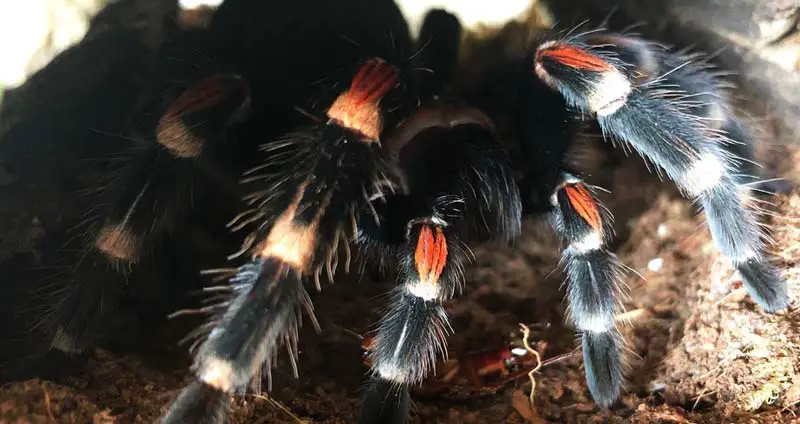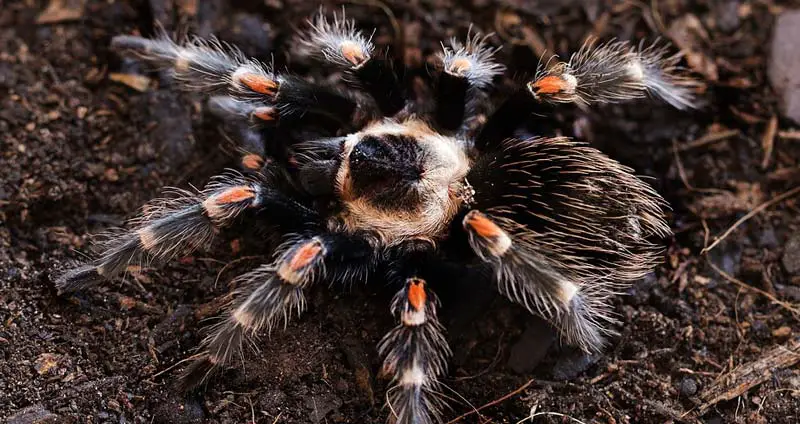Brachypelma auratum, or the Mexican Flame Knee tarantula, boasts lustrous bright red and orange stripes on its knees. Although there are well over 800 different types of tarantulas, the Mexican Flame Knee enjoys a unique place among exotic pet enthusiasts due to a docile personality, bright appearance, large size, and low maintenance.
Table of Contents
Brachypelma auratum Care Sheet
|
|
|
Common Name |
Mexican Flame Knee |
Species Type |
New world terrestrial |
Natural Habitat |
Found in the regions of Guerrero and Michoacán in Mexico. Primarily lives in areas with decent amounts of brush. |
Growth Rate |
Medium growth rate, reaching full size in a couple of years. |
Adult Size |
Females reach a legspan of between 5″ and 6″, with males measuring slightly smaller. |
Lifespan |
Females can live up to 15 years, while males often only live to 4 years. |
Enclosure |
The enclosure should be wider than it is tall, with plenty of substrate to create burrows in. A hide should be present, as should a consistently-filled water dish. |
Temp/Humidity |
78°F to 82°F with about 60% to 70% humidity. |
Diet |
Good eater that can eat several adult-sized crickets per week. Dubia roaches and mealworms should be used as supplemental food. |
Temperament |
Quite a docile tarantula. Almost never flicks hairs and prefers to run from danger as opposed to fighting it. |
Experience Level |
Beginner – A tarantula species that’s easy to care for and hardly dangerous. Great for beginners. |
Average Cost |
Slings ~ $30, Males ~ $75, Females ~ $125+ |
Brachypelma auratum Appearance
If you’re a tarantula enthusiast and want to add a unique spider to your collection, then the heavy-bodied Brachypelma auratum is a good choice. A cursory glance at the Brachypelma auratum reveals a very similar appearance to the much more popular Brachypelma smithi or the Mexican red-kneed spider.
A closer inspection, however, shows that the Brachypelma auratum has a darker appearance with more prominent red stripes along its carapace. The Mexican red-kneed tarantula has a vivid red and orange color on all its leg joints, unlike the Brachypelma auratum.
As spiderlings, these tarantulas look very similar to fully-grown adults and are extremely active in their cages, making them excellent display spiders.
Mexican Flame Knees typically stop growing after six years. It is common for adults to grow up to six inches if you provide them with constant nutrition at the right temperature and humidity.


via @tarantulateacher / Instagram
Brachypelma auratum Temperament
Brachypelma auratum is a new world tarantula, which means they are timid and go out of their way to avoid danger. Unless they feel cornered, most Flaming Knees will never act aggressively and won’t even flick off their hairs – provided you treat them right.
What makes this tarantula particularly desirable is its docile personality: it’s not aggressive and very skittish. Although it isn’t best to get too close with the spider, Flame Knees can be handled rather easily.
It is worth noting that just like other Brachypelma tarantulas, Flame Knees have urticating hairs on their abdomen that they will flick off at the slightest hint of provocation and intimidation. Try not to hold these spiders too close to your face.
Like all tarantulas, the Brachypelma auratum is susceptible to fall-related hazards that could critically injure their abdomens, leading to instant death for some spiders. Unless you’re uncomfortable around spiders, we do not recommend handling them over tall heights unless you have a padded surface to absorb fall damage if it occurs.
As a ground-dwelling tarantula, Brachypelma often seeks refuge from harsh weather and lurking predators. They have been known to passively share the same space with a small frog known as the Eleutherodactylus occidentalis.
Housing Brachypelma auratum
It isn’t difficult to arrange a decent enclosure for Flame Knee tarantulas. They require very little maintenance once they reach their average leg span of about 5” to 6”. Unlike bigger species like the Salmon Pink or the Goliath Birdeater, the Mexican Flame Knee does not require complicated enclosures.
Optimal Brachypelma auratum Enclosure
A terrestrial cage with dimensions 18”x 18”x 12” will do just fine for adults, while the spiderlings can also live in smaller containers. You could also opt for larger cages since the Flame Knee tarantula prefers to sit out in the open for extended periods. This will make for very impressive displays.
The ideal cage should give the tarantula lots of room for ample landscaping and webbing so that they can mimic their natural habitats. Exo Terras have excellent cages for Mexican Flame Knees because they feature lots of decorations that enhance the beauty of the tarantula.
Enclosure Decorations
Although the Mexican Flame Knee does not require special arrangements and decorations, a few different supplies can go a long way in making their cage look more attractive. Just make sure to add 2 to 3 inches of a moderately moistened substrate on the ground.
Brachypelma auratum lives in burrows and under stones and logs, so don’t forget to place a tarantula hide on top of the substrate. You should consider the size of your tarantula when choosing a hide. They should be able to fully conceal themselves beneath the hide, the same as they would in the wild, making them feel safe and secure in their enclosure. Feel free to add fake plants to spruce things up.
Don’t forget to add a water dish that your tarantula can easily reach. Remember, both nourishment and hydration go hand in hand.
If you decide to add live plants, then you’ll need to add a light source to keep the flora alive. This may seem counterintuitive since Mexican Flame Knees are nocturnal animals and shun bright light. But if you’re adamant about using live plants, you could still make do with small compact fluorescent tubes for lighting.
Enclosure Humidity/Heating
The Brachypelma auratum prefers a dry environment and avoids soggy conditions. The cage should be well-ventilated to maintain a healthy humidity level. It is a good idea to spray the cages once a week to temporarily raise the humidity levels, before allowing it to drop down again.
It is important to give your tarantula access to fresh water at all times to ensure it stays hydrated. The water bowl should be regularly sterilized, cleaned, and refilled. You may want to place the water bowl at the cooler end of the cage to reduce the rate of evaporation, or else the water will dry faster than you anticipate!
The Mexican Flame Knee prefers warm, arid environments. Regular room temperature may not be suitable for this species. If the ambient temperature is not warm enough, you might need some form of artificial heating to increase the temperature. The heating setup should be arranged in such a way that one side of the cage should be hotter than the other.
At the hot end, you should aim for a temperature range between 78°F to 84 °F. This allows the tarantula to escape to a cooler area of the cage if it feels necessary. You can monitor the temperature and humidity at all times with a simple thermometer and hygrometer.
Diet
Mexican Flame Knee tarantulas have a medium growth rate, which means they won’t eat very frequently. They will attain full growth if their nutritional needs are met. For the most part, they will eat a suitably-sized insect once every 5 to 7 days.
If your spider always seems to be starving, try to increase its meal portions and feed it more often. However, if your spider isn’t interested in eating, then you don’t have to feed it regularly. Don’t be afraid to over-feed your Brachypelma auratum.
Ideal insects for this spider species include crickets, roaches, and locusts. Once your tarantula is done with feeding, make sure to remove any uneaten food from the cage. If your tarantula refuses to eat, it might be molting. It isn’t uncommon for tarantulas to stop eating for extended periods, ranging from a few weeks to several months.
Health Concerns
The Brachypelma auratum is popular for being fairly low maintenance with the only concern being internal injuries from falling off tall heights. They’ll be fine as long as you keep the cage’s temperature and humidity at optimum levels. You may face problems with mites, parasites, and dehydration, but these can be easily avoided.
In case your tarantula refuses to eat, then it may be molting. Make sure to take extra care for them during this sensitive time.
Brachypelma auratum For Sale & Price
Prepare to pay a heavy price if you want to adopt this tarantula. Although the Brachypelma auratum isn’t as popular as it’s cousin the Brachypelma smithi, it is still quite expensive. Most vendors and online marketplaces will sell them for around $125. Thanks to their docile nature, alluring appearance, and low-maintenance, these tarantulas are well worth the extra cost.

